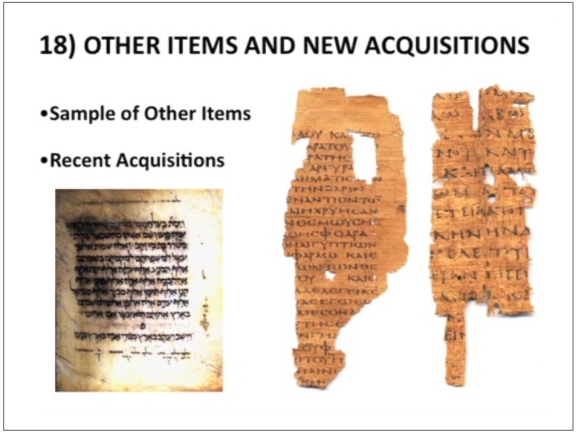In my last post, I highlighted a papyrus of Genesis mentioned by Scott Carroll in his 2011 lecture in the “Passages” speakers series. Later in that same talk, Carroll singled out two other pieces in the collection, a papyrus leaf from a codex of Exodus in Greek and a fragment of a papyrus copy of Hebrews.

Here is some of what Carroll had to say about these pieces:
“As far as new acquisitions: Ah, they’re ongoing. I’m very appreciative of the aggression to–and we want, not unwisely but wisely to build this collection out. So it’s a wonderful repository . . . These were recently acquired things. We’re acquiring Hebrew, ah, medieval manuscripts. These were just picked up this week. Steve, here they are. Um, let’s see if we can see what this is. It’s on papyrus, and I see “Mos-sees.” I see the name Moses. I see the name, let’s see here; let’s go down: “Ee-gyp-ti-on,” Egyptian, alright? Um, so we must be in the book of Exodus here, and in fact we are, with a beautiful papyrus on display from the book of Exodus. What about this ragged fragment? Well this ragged fragment here is the second earliest text of the book of Hebrews in the world. And two nights ago I was looking at it, and identified that it is coming from chapter 9.”
The slide on display at this point in the lecture offers a clue about the identity of the Exodus fragment (center):

Slide from a lecture by Scott Carroll showing papyri in the Green Collection (“The Green Collection, Scientific Breakthroughs and Bible Translation,” 23 August 2011, Oklahoma City)
In fact, this leaf of Exodus, containing parts of Exodus 11 and 12, had already been published back in 2007 by David deSilva along with other fragments from the same codex in an article called “Five Papyrus Fragments of Greek Exodus” in the Bulletin of the International Organization for Septuagint and Cognate Studies. In that article, deSilva describes the pieces as belonging to an “anonymous owner.” But this particular leaf, easily identifiable by its unique shape, can be traced a little further back, to at least 2005, when it was a part of the “Ink & Blood” travelling exhibit associated with William Noah and Bruce Ferrini. The flip side of it appears on the back cover of a catalog from 2005:

Back cover of Ink & Blood: Dead Sea Scrolls to the English Bible ( Murfreesboro, Tenn.: ACO, LLC, 2005)
This papyrus leaf of Exodus is known to come from a codex (LDAB 8121) that was said to have been discovered together with the so-called Tchacos Codex containing the Gospel of Judas. I described this codex last year in a piece for the Ancient Jew Review. This book was badly dismembered on the antiquities market and is the topic of a forthcoming study by Jeremiah Coogan.
As Carroll mentioned in his lecture, the papyrus of Hebrews (far right in the image of the slide) contains fragments of lines from Hebrews 9; so, this is most likely the item catalogued as P130 on the INTF Liste:
P130: Hebrews 9:9-12 and 9:19-23 (GC.PAP.000401)
The provenance of the Hebrews fragment is not known (to me, at least). Carroll mentions that it was purchased “this week,” i.e. sometime in the middle of August 2011. I am not sure where his busy travel itinerary placed him that week. But it would seem, then, that this papyrus is not the same object the Green Collection papyrus of Hebrews that was on display in April 2011 nor the papyrus purchased by Carroll in October 2011:

It’s not clear from where Carroll was returning with that papyrus, either. Surrounding Tweets suggest the U.K., but, as I said, Carroll was travelling widely in those days, so it’s hard to be certain. In any event, more information that we look forward to learning from the relevant people associated with Green Collection and perhaps the Museum of the Bible.


Reblogged this on Talmidimblogging.
Reblogged this on Zwinglius Redivivus and commented:
Fun times.
Brent,
In Carrol’s tweet (20 Oct. 2011), he doesn’t say that he purchased P130 but was returning with it to the U.S. Unless I overlooked something, we should also consider the possibility that he purchased P130 in Aug. 2011 and had taken it to the UK in Oct. to have it examined by a third-party (perhaps at Oxford?). If this is the case, then the tweet could be referencing P130 and not a third Hebrews text. I think this is plausible because, thanks to the “first-century Mark” fiasco, we know that in 2011 Carrol and Pattengale were interacting with a papyrologist at Oxford who was working with the Green Collection and was one of the editors for their papyri text with Brill.
By the way, when Heb. 11 was on display, the Green Collection claimed that it was also written on a re-used papyrus roll.
Thanks, David. Yes, that earlier purchase date for P130 is possible. Another point to keep in mind is the way Scott Carroll tends to talk about acquisitions and discoveries. I know the Green Collection was getting lots of new material in 2011 and 2012, but, in watching all these videos, you begin to sense a pattern in Carroll’s presentations: He has always “just discovered” or “just acquired” something spectacular (“the earliest copy of X”). It all seems a little too good to be true.
Pingback: More Early Christian Greek and Coptic Papyri in the Green Collection? | Variant Readings
Pingback: More of Scott Carroll’s Papyri? | Variant Readings
Pingback: Recently Emerged Papyri of Dubious Origins: A Working List | Variant Readings